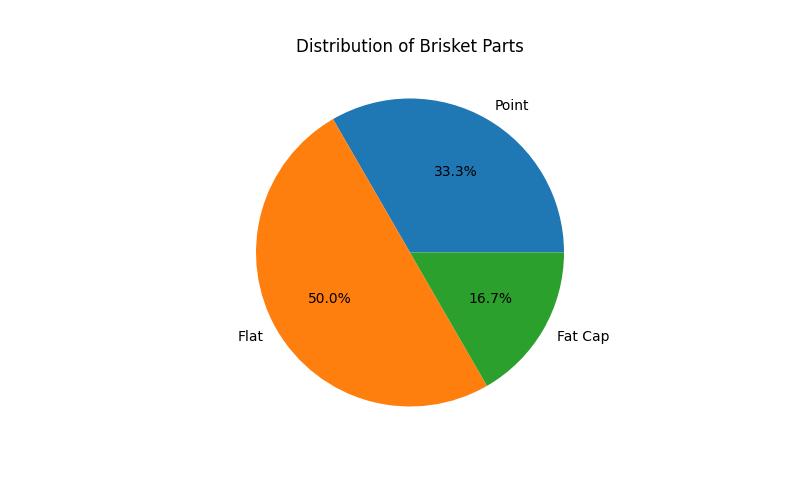If you’re a fan of beef, then you’ve probably heard of brisket. This popular meat cut is renowned for its rich and smoky flavor, which makes it one of the most sought-after dishes for BBQ enthusiasts. However, when it comes to selecting a brisket, there are two primary cuts to choose from: the whole brisket and the flat. So, which cut reigns supreme for BBQ? Let’s find out.
Learning about the difference between whole brisket and flat
- Whole brisket includes the point and the flat while the flat is only a section of the brisket.
- Whole brisket has more fat and connective tissue which means more flavor but requires longer cooking time.
- Flat is leaner and easier to cook but lacks some of the flavor that the whole brisket provides.

Understanding the Whole Brisket
The whole brisket, also known as the packer brisket, is a large cut of meat that includes both the flat and the point. The point is the thicker, fattier end of the brisket, while the flat is the leaner end. The whole brisket typically weighs between 12-18 pounds and requires a longer cooking time to reach the desired tenderness.
One of the advantages of cooking a whole brisket is that you get both the lean and fatty parts of the meat, which can result in a more complex and flavorful dish. The point is especially prized for its marbling, which can add a rich and beefy flavor to the brisket.
Cooking a whole brisket requires a bit more skill and attention than cooking a flat. The thicker point can take longer to cook than the thinner flat, which can result in uneven cooking and a potentially tough end product if not properly handled.
The Benefits of Cooking a Flat Brisket
The flat brisket, also known as the first cut, is a leaner cut of meat that includes only the flat section of the brisket. It typically weighs between 5-8 pounds and cooks faster than a whole brisket.
One of the main advantages of cooking a flat brisket is that it is easier to handle and cook evenly than a whole brisket. Its leaner profile also means that it is a healthier option for those watching their fat intake.
However, the downside of cooking a flat brisket is that it lacks the marbling and fat content of the point, which can result in a less flavorful end product. Additionally, because it is a leaner cut, it can also be more prone to drying out if not properly cooked.

Cooking Tips for Whole Brisket vs Flat
| Tips for Cooking Flat Brisket | Description |
|---|---|
| 1. Trim the fat | Since flat brisket is already a leaner cut, it’s important to trim any excess fat to avoid the meat becoming too dry. Leave only about 1/4 inch of fat on the surface to help add flavor and moisture. |
| 2. Use a marinade | Marinating the flat brisket can help tenderize the meat and add flavor. A simple marinade of olive oil, salt, pepper, and garlic is a good starting point. Let the meat marinate for at least 2 hours or overnight in the refrigerator. |
| 3. Cook low and slow | Flat brisket should be cooked low and slow, just like the whole brisket. This will help break down the connective tissue and make the meat tender. A smoker or oven set to 225-250 degrees Fahrenheit is ideal for cooking flat brisket. |
| 4. Wrap in foil | Wrapping the flat brisket in foil after a few hours of cooking can help prevent it from drying out. This technique, known as the Texas Crutch, allows the meat to steam in its own juices and become more tender. However, be careful not to wrap it too tightly as this can also cause it to become mushy. |
| 5. Use a meat thermometer | To ensure that the flat brisket is cooked to the proper internal temperature, use a meat thermometer. The meat should reach an internal temperature of 195-205 degrees Fahrenheit. |
| 6. Let it rest | After cooking, let the flat brisket rest for at least 30 minutes before slicing. This allows the juices to redistribute throughout the meat, resulting in a more tender and flavorful end product. |
| 7. Slice against the grain | When slicing the flat brisket, be sure to cut against the grain to help keep the meat tender. The grain refers to the direction of the muscle fibers, which can be identified by the lines running across the meat. Cutting against the grain means cutting perpendicular to these lines. |
| 8. Serve with a sauce or rub for added flavor and moisture | To enhance the flavor and moisture of the flat brisket, consider serving it with a sauce or rub. A simple sauce made from ketchup, Worcestershire sauce, apple cider vinegar, and brown sugar is a great accompaniment. Alternatively, a dry rub made from paprika, garlic powder, brown sugar, and salt can help add flavor to the meat. |
| 9. Experiment with different woods for smoking to add more flavor | The type of wood used for smoking can also have an impact on the flavor of the flat brisket. Hickory, oak, and mesquite are popular choices for a smoky and robust flavor. Fruitwoods such as apple or cherry can add a sweeter and more subtle flavor. |
Regardless of which cut you choose, there are some general tips and tricks that can help you achieve a delicious and tender brisket.
Seasoning
When it comes to seasoning a brisket, less is often more. A simple rub of salt, pepper, and garlic powder can be enough to enhance the natural flavors of the meat. Some pitmasters also like to add a bit of paprika or chili powder for a smoky and slightly spicy taste.
Smoking
Smoking is the traditional method for cooking a brisket, and many BBQ enthusiasts swear by it for achieving the best results. A smoker allows you to cook the meat low and slow, infusing it with a rich and smoky flavor.
Temperature
When cooking a brisket, it’s important to monitor the temperature carefully to ensure that it cooks evenly and reaches the desired level of tenderness. A meat thermometer can be a valuable tool for this, allowing you to check the internal temperature of the meat without cutting into it.
Resting
After cooking, it’s important to allow the brisket to rest for at least 30 minutes before slicing. This allows the juices to redistribute throughout the meat, resulting in a more tender and flavorful end product.

Pros and Cons of Whole Brisket vs Flat
Here’s a quick rundown of the pros and cons of each cut:
Personal Story: My Journey to Discovering the Best Brisket Cut
As a self-proclaimed brisket enthusiast, I have spent countless hours researching and taste-testing various brisket cuts. In my quest for the perfect brisket, I stumbled upon a local BBQ joint that served both whole and flat brisket cuts.
At first, I was a die-hard whole brisket fan, believing that the flat cut was too lean and lacked the juicy flavor that the whole cut provided. However, after trying both cuts side-by-side at the same restaurant, I realized that I had been missing out on the deliciousness of the flat cut.
The flat cut had a perfect balance of lean meat and fat, providing a tender and flavorful bite with each piece. The whole cut, while still delicious, was slightly tougher and lacked the same level of flavor that the flat cut had.
Since that day, I have been a convert to the flat cut and have been recommending it to all of my fellow brisket lovers. It just goes to show that sometimes, you have to step outside of your comfort zone and try something new to discover the best of the best.
Whole Brisket
Pros:
– Offers a more complex and flavorful dish due to the marbling of the point
– Can be a show-stopper for larger gatherings
– You get both lean and fatty parts of the meat
Cons:
– Can be more challenging to cook
– Longer cooking time
– Thicker point can take longer to cook than the thinner flat
Flat Brisket
Pros:
– Easier to handle and cook evenly
– Cooks faster than a whole brisket
– Leaner profile makes it a healthier option
Cons:
– Lacks the marbling and fat content of the point, which can result in a less flavorful end product
– More prone to drying out if not properly cooked
Nutritional Value of Brisket
Brisket is a rich source of protein and essential nutrients, such as iron and vitamin B12. However, it is also high in fat and calories. A 3-ounce serving of brisket contains about 240 calories and 21 grams of fat. Therefore, it’s important to consume brisket in moderation as part of a balanced diet.
Conclusion
In conclusion, whether you choose the whole brisket or the flat for your BBQ, it largely depends on personal preference and cooking skill level. The whole brisket can offer a more complex and flavorful dish, but it can be more challenging to cook. The flat brisket, on the other hand, is easier to handle and can be a healthier option but may lack the richness and depth of flavor that the point provides.
Regardless of which cut you choose, following proper seasoning, smoking, temperature monitoring, and resting techniques can help you achieve a mouth-watering and tender brisket that will be the star of your next BBQ.
Insider Tip:
When selecting a brisket, look for one with a good fat cap, which can help keep the meat moist during cooking. Additionally, consider using a water pan in your smoker to add moisture to the cooking environment and prevent the brisket from drying out.
FAQ
Q.What’s the difference between whole brisket and flat?
A.Whole brisket includes both flat and point cuts, while flat is only one of the two.
Q.Who should choose whole brisket over flat?
A.Whole brisket is preferred by those who want more flavor and a juicier texture.
Q.How do I cook a whole brisket?
A.Slow cook it at low temperatures for several hours, until it reaches an internal temperature of 195°F.
Q.What if I only want to cook a flat brisket?
A.Flat brisket is easier to cook and a good option for those who prefer a leaner cut.
Q.How can I make sure my brisket doesn’t dry out?
A.Keep the meat moist by wrapping it in foil or spraying it with a liquid during cooking.
Q.Isn’t whole brisket more expensive than flat?
A.It can be, but the extra cost is worth it for the added flavor and texture.
Follow us!!